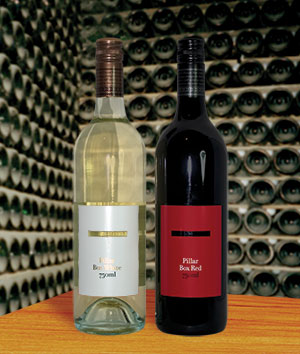
My Baby, She Wrote Me A Letter
And if my baby was Australian, she would have mailed it from a pillar box, which is what mail boxes are called Down Under as well as in England.
Pillar boxes lined the coach-driven mail routes, or ‘drives,’ established in the 1850s to provide mail service to the farmers and settlers then moving into southeastern South Australia. One such route in Padthaway was operated by Henry John Hill, and ran through property now owned by the third generation of the Longbottom family.
In 1992 Kim and Mark Longbottom decided to expand their farming operation into winemaking, and released their first offering in 1996. In a nod to the history of the mail route that once passed through the vineyards, today the family’s wine business is known as Henry’s Drive Vignerons.
The Padthaway region was once covered by the ocean. The receeding waters left behind a limestone subsoil topped by rich red loamy earth. This soil structure combines with good winter rains and mild sunny summers to make Padthaway well-suited for viticulture. The first vines were planted there in 1964, and it has come to be one of Australia’s premier wine-producing regions.
Pillar Box Red 2005
A blend of 57% cabernet sauvignon, 32% shiraz, and 11% merlot. The color is opaque purple, with a European-style flavor profile. The fruit is somewhat recessive, with nice astringency and enough tannin for structure. An excellent value, and 2005 is only the second vintage.
Pair this muscular wine with roasted or grilled beef or pork, blue cheese stuffed hamburgers, or a full-flavored, tomato sauced lasagna.
Pillar Box White 2006
A blend of 66% chardonnay, 20% sauvignon blanc, and 14% verdelho. The dominant taste is grapefruit, supported by lemon and citrus zest and racy, minerally acid. This makes for a tart, zippy, refreshing wine, ideal for this time of year. The color is pale straw yellow with a green tinge.
Try this wine with grilled or baked fish, a cheese course, shrimp on the barby (of course), or even tortilla chips and salsa.
This month’s wines are both sealed with screw caps. Screw caps have long been associated with low-quality wines. However, this has begun to change because of the perennial problem of “cork taint.” Cork taint is caused by complex chemical mechanisms triggered by the presence of microscopic fungi in the cork. Although not hazardous, cork taint does ruin the wine with a musty, wet cardboard smell and taste.
Screws caps are seen as a solution to this problem, and less tradition-bound Aussies are using them extensively on wines at every quality level. Commendable as that may be, I still prefer a cork, even if it is a well-made artificial one.
Top of page: https://winervana.com/blog/
